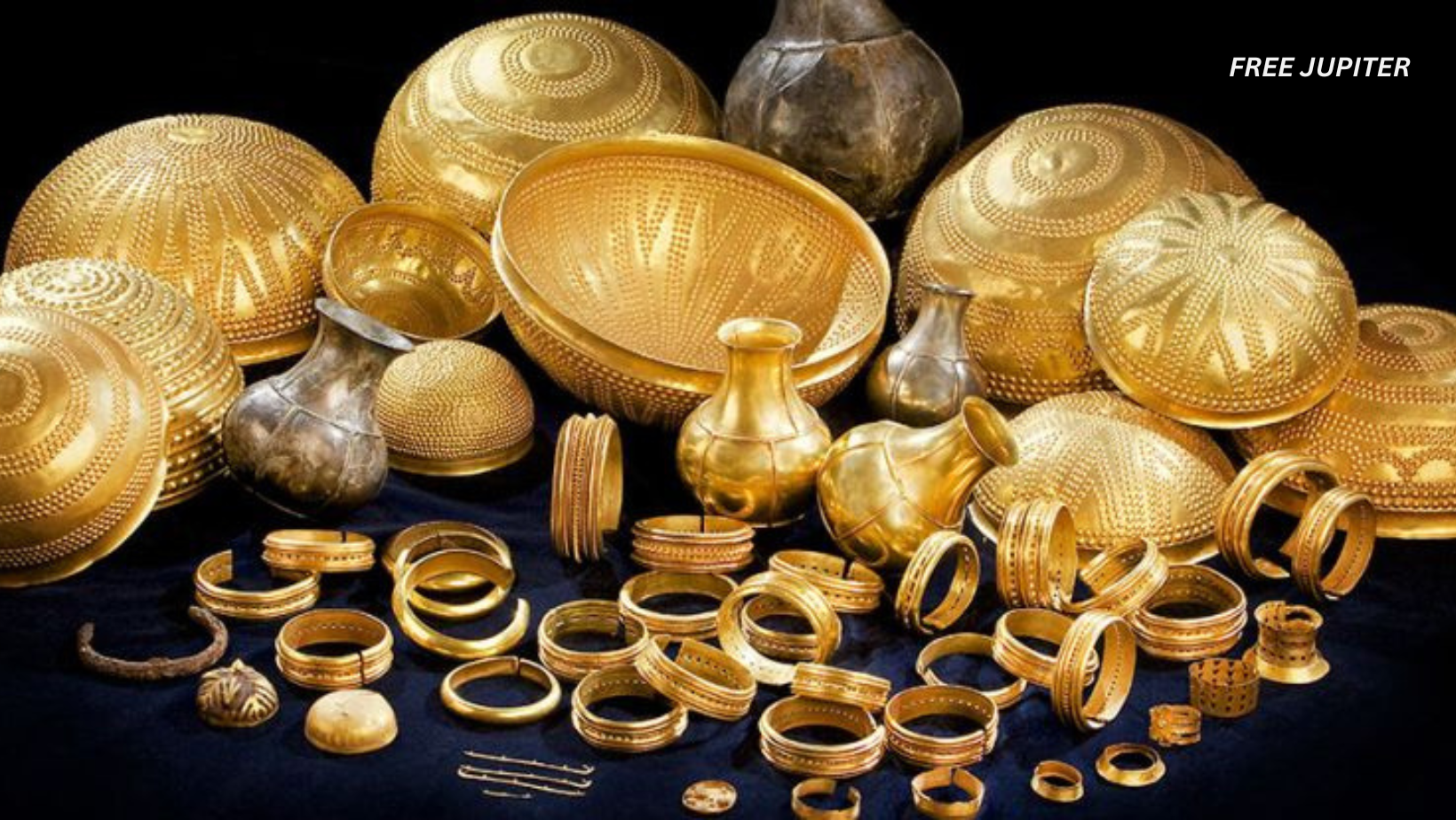Friendly Note: FreeJupiter.com shares general info for curious minds 🌟 Please fact-check all claims—and always check health matters with a professional 💙
In the rolling landscapes of eastern Spain, an extraordinary find has continued to captivate archaeologists and historians for more than six decades. The Treasure of Villena, a glittering collection of Bronze Age artifacts, has long dazzled with its gold and craftsmanship. Yet, recent scientific investigations have revealed that the most remarkable pieces in this ancient hoard are not the ones that shine brightest, but rather those forged from material that quite literally fell from the sky.
A Discovery That Sparked Curiosity
The story of the Villena Treasure began in 1963, when workers stumbled upon a cache of artifacts in a gravel pit near the town of Villena, Alicante. The collection, now recognized as one of the most significant Bronze Age finds in Europe, consists of 59 gold items including bracelets and bowls alongside a handful of silver and iron objects. The sheer quantity and quality of these objects immediately drew attention, but the true extent of their significance would only come to light decades later.
The Unassuming Stars: Iron Artifacts With a Secret
Among the gold and silver treasures, two iron objects stood out for their unusual appearance: a heavily corroded bracelet and a hollow hemisphere adorned with a delicate gold sheet, possibly once the top of a ceremonial staff or the pommel of a sword. At first glance, these iron pieces seemed less impressive than their golden counterparts. However, subtle clues in their composition hinted at something extraordinary.
Early researchers noted that these iron artifacts displayed a distinct, leaden hue and were covered in a cracked, oxidized layer, unlike typical terrestrial iron objects of the era. It was only through recent advances in analytical techniques that the true nature of these items was uncovered.
Tracing the Metal’s Celestial Journey
A team led by Salvador Rovira-Llorens, formerly of Spain’s National Archaeological Museum, along with Martina Renzi and Ignacio Montero-Ruiz, embarked on a detailed study of the two mysterious iron artifacts. Using advanced mass spectrometry and elemental analysis, they discovered that both pieces contained significant amounts of nickel—an element rarely found in such high concentrations in Earth’s iron ores but common in material from iron meteorites.
The composition of the artifacts closely matched that of the Mundrabilla meteorite, which landed in Australia less than a million years ago. While researchers cannot definitively link the Villena objects to a specific meteorite, the evidence is clear: these are the oldest known meteoritic iron artifacts on the Iberian Peninsula, crafted between 1400 and 1200 BCE, well before the widespread adoption of iron smelting in the region.
Read more: Many Of The Dead Sea Scrolls May Be Older Than We Thought, Experts Say
Why Meteoric Iron?
In the Late Bronze Age, the technology to extract iron from terrestrial ores had not yet reached the Iberian Peninsula. Meteoric iron, with its distinctive iron-nickel alloy, was one of the few sources of workable iron available to ancient craftspeople. Its rarity and celestial origin likely imbued it with special significance, making it a material reserved for objects of great importance or ceremonial value.
Across the ancient world, meteoric iron was sometimes used for tools, weapons, and ornaments, often carrying symbolic or spiritual meaning due to its cosmic origins. The Villena artifacts join a small but growing list of such objects, including arrowheads from Switzerland and ceremonial items from Egypt and Turkey, illustrating a shared fascination with materials from beyond our planet.
The Artistry and Ingenuity of Ancient Iberia
The creation of the Villena iron artifacts required not only access to meteoric material but also advanced metallurgical skills. The bracelet and the gold-capped hemisphere were carefully shaped and decorated, demonstrating a level of craftsmanship that challenges previous assumptions about the technological capabilities of Bronze Age Iberian societies.
The Villena Treasure as a whole, with its intricate goldwork and unique iron pieces, stands as a testament to the sophistication and creativity of its makers. The fact that these artisans could recognize, value, and work meteoric iron speaks to their ingenuity and their ability to incorporate rare materials into their cultural and ceremonial practices.
Read more: We’ve Just Found Out How Our Brains Sort Imagination From Reality
Unanswered Questions and Ongoing Mysteries
Despite the breakthroughs in understanding the origins of the Villena iron artifacts, many questions remain. How did the ancient Iberians acquire meteoric iron? Was the meteorite found locally, or did the material travel across long distances through trade or exchange networks? Who were the skilled individuals responsible for transforming this cosmic metal into objects of prestige and power?
Researchers continue to investigate these mysteries, hoping that further analysis and future discoveries will shed light on the connections between ancient communities and the broader world around them—including the cosmos itself.
The Treasure’s Enduring Legacy
Today, the Treasure of Villena is housed in a secure display at the local archaeological museum, where it continues to inspire awe and curiosity. Its gold objects remain a dazzling example of Bronze Age artistry, but it is the unassuming iron pieces—born of fire and forged from the remnants of a meteorite—that now capture the imagination of scientists and the public alike.
The revelation that ancient Iberian metalworkers crafted objects from extraterrestrial iron not only rewrites the history of metallurgy in the region but also highlights the deep connection between humanity and the wider universe. The Villena Treasure serves as a vivid reminder that, even thousands of years ago, people looked to the skies for inspiration, materials, and meaning.
A Broader Context: Meteoric Iron Across the Ancient World
The use of meteoric iron in ancient times was not unique to Iberia. Before the development of iron smelting, communities in Egypt, Turkey, and Syria also fashioned tools and ceremonial objects from meteorites. The most famous example is the dagger found in the tomb of Tutankhamun, whose blade was forged from meteoric iron and remains a symbol of both technological achievement and cosmic wonder.
These discoveries highlight a period in human history when the boundaries between earth and sky were more fluid, and when the arrival of a meteorite could transform the lives and beliefs of entire communities. The Villena Treasure, with its blend of terrestrial gold and celestial iron, embodies this spirit of curiosity and innovation.
Read more: Who Really Wrote the Bible? Groundbreaking New Algorithm Challenges Centuries of Belief
Conclusion: Bridging Worlds, Past and Present
The ongoing research into the Villena Treasure is more than a tale of ancient gold and iron. It is a story of discovery, adaptation, and the enduring human desire to reach beyond the familiar. By unraveling the secrets of these remarkable artifacts, scientists are not only piecing together the history of Iberian metallurgy but also exploring the ways in which ancient societies understood and engaged with the wider cosmos.
As new analytical techniques emerge and further studies are conducted, the Treasure of Villena will undoubtedly continue to yield insights into the lives, skills, and aspirations of those who created it. In the meantime, its iron artifacts—once dismissed as little more than curiosities—stand as a cosmic bridge between the earthbound and the celestial, a testament to humanity’s timeless fascination with the stars










